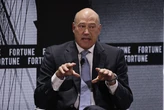Hello and welcome to Modern CEO! I’m Stephanie Mehta, CEO and chief content officer of Mansueto Ventures. Each week this newsletter explores inclusive approaches to leadership drawn from conversations with executives and entrepreneurs, and from the pages of Inc. and Fast Company. If you received this newsletter from a friend, you can sign up to get it yourself every Monday morning.
Nearly 20 years ago, Harvard Business School professor Clayton Christensen published The Innovator’s Dilemma: When New Technologies Cause Great Firms to Fail, his groundbreaking work about why successful companies often lose their way. But CEOs still struggle with one of the book’s central lessons, which is that companies need to disrupt themselves.
“Companies certainly know more about disruption than they did in 1995, but I still speak and write to executives who haven’t firmly grasped the implications of the theory,” Christensen told former Harvard Business Review editor and Inc. columnist Karen Dillon in an interview published shortly after his death in 2020. “The forces that combine to cause disruption are like gravity—they are constant and are always at work within and around the firm. It takes very skilled and very astute leaders to be navigating disruption on a constant basis.”
New paths and challenges
Indeed, even after leaders make the difficult decision to shed traditional and reliable revenue streams to invest in new products and services, executing such transitions can take years. Such lags can test the patience of investors and other stakeholders, especially when there’s no guarantee that the new business model will succeed.
Just ask Michael Weening, president and CEO of Calix, Inc., which took 13 years to transform itself from a networking gear maker into a software and managed services company for rural broadband providers. The company was founded in 1999, at a time when startups and enterprises alike were rushing into the lucrative business of making gear to power the internet. (Remember when Cisco Systems was the most valuable company in the world?)
But a decade later, enterprises started to change the way they were deploying technology, moving to cloud-based solutions that began to minimize the need for companies to maintain their own computing equipment. Calix leaders saw the change coming and began laying the groundwork for an entirely new approach in 2012—one that reimagined the company as a software and cloud company for rural broadband service providers. The company hired Weening from cloud trailblazer Salesforce in 2016 to help with the transition.
However, a year later, the company’s annual loss had widened to more than $80 million from $27 million on revenue of about $450 million as Calix realigned the business to focus on investments in its software business. The market cap fell to $275 million, about two-thirds of its value at the time of its 2010 initial public offering.
Staying the course
Weening credits Carl Russo, Calix’s founder and chairman, with having the patience to weather losses. He says: “The founder was the largest shareholder, who could in essence say to the market, ‘We’re making these massive investments because if we don’t do this, we’re going to turn into a low-margin commodity business.’”
In addition to making changes to Calix’s core business model and business infrastructure, Weening and his leadership team had to bring in new talent, resulting in restructuring costs for severance and termination benefits.
Another big challenge was convincing Calix’s clients, the rural broadband operators, to embrace Calix’s new offering. Rather than selling them gear for their fiber optic networks, Calix wanted to offer a cloud and software platform—with a host of fully integrated managed services, some of which the broadband companies could then sell to their consumers and business customers. For example, Calix customers can sell residential customers a subscription to Bark, a social media-monitoring service for parents. “They’re great at construction; they’re great at reliability and running a network, but this new world of broadband is around experiences,” Weening says. “How do you teach them how to be sales and marketing- and experience-orientated?” Weening drew on his experiences leading customer success at Salesforce to develop resources and training to help Calix clients take advantage of its products and services.
New outcomes—a decade later
The transformation is starting to pay off. The company in 2023 made Fortune’s list of the 100 fastest-growing companies of the year based on growth in revenue, profits, and stock returns. The company reported lower revenue and losses in 2024 but recently reported first-quarter earnings that beat expectations. Calix’s market capitalization is about $2.4 billion.
Ask Weening what he thinks about disrupting Calix now, having gone through a 13-year transformation: He and the company say transformation is ongoing, and he says he relies on his customers to keep innovation on track. “You can never get arrogant,” he says. “You always have to be listening. We have 10 advisory customer boards. And if you’re not arrogant, everyone will tell you where you suck.”
He also offers a reminder of why so many companies resist tackling the innovator’s dilemma, even when they understand the risks of inaction. “This,” he says, “is not for the faint of heart.”
How does your company navigate disruption?
Has your company faced the innovator’s dilemma? How do you, in Christensen’s words, navigate disruption on a constant basis? Send your stories and anecdotes to me at [email protected]. I’d like to share your examples in a future newsletter.
Read more: innovator’s dilemma
Why companies fail to innovate. An excerpt from The Innovator’s Dilemma
Basecamp founder Jason Fried talks to Clayton Christensen
How Steve Jobs solved the innovator’s dilemma










No comments